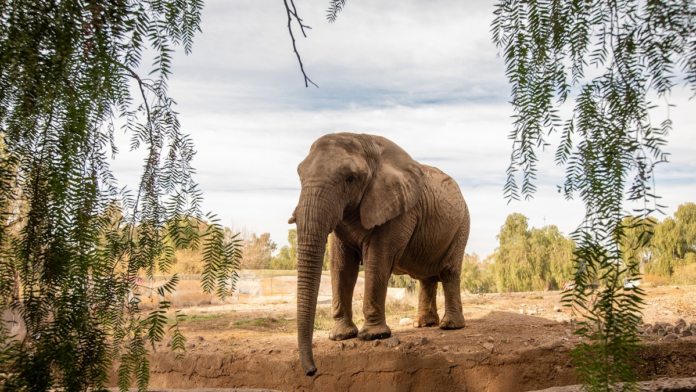On a hot day in July, Kenya the elephant was taking her time to exit her transport crate and enter her new home. But after 30 minutes, the 13,200-pound African elephant stepped out of the crate, shook off the dust, briefly explored her surroundings, then proceeded to roll in a mound of red earth.
“She did it like a little girl,” says Juan Ignacio Haudet, director of biodiversity and ecopark of Mendoza City in Argentina. It was the first time in the last three years of working with her that he had seen her frolic, bathe her entire body, or even enjoy food.
Kenya was the last captive elephant in Argentina. She arrived at the Global Sanctuary for Elephants in Brazil, the only elephant sanctuary in South America, after several months of rehabilitation at the Ecopark of Mendoza City, where she had lived her entire 40 years of life in captivity.
(Elephants are learning to live with us. Can we do the same?)
Her release earlier this year was made possible by a 2016 Argentine law—passed amid growing public pressure and advocacy from animal protection groups—mandating the closure of the nation’s zoos, their transformation into ecoparks, and the relocation of exotic animals to sanctuaries or rescue centers.
The team that traveled with Kenya to Brazil says she arrived at the sanctuary trumpeting, as if making a triumphant entrance that marked the end of 136 years of elephant captivity in Latin America’s second largest country.
A years-long journey
It was a difficult journey to get here.
EXPLORE THIS PACIFIC PARADISE
Where guests are guardians
Asian elephant Pelusa was the first elephant in Argentina selected for relocation. Like Kenya, she spent her entire life alone, though she lived at the La Plata Zoo. But Pelusa died in 2018 at age 52, just days before her transfer to the Global Sanctuary for Elephants.
(What happens when elephants live alone.)
That wasn’t the only loss. Merry, an Asian elephant kept in a private zoo who performed from a very young age in a circus, died that same year at age 50. In 2024, while waiting for international permits for relocation and cross-border travel, African elephant Kuky passed away at just 34 years old. And just a few weeks before Kenya’s trip this year, Tamy—a 55-year-old Asian male who had already completed his rehabilitation process—died as well.
In the wild, the average age of a healthy elephant is between 60 and 70 years, but that average changes significantly for elephants forced into confinement. In Kenya’s case, decades spent in captivity took a gradual but relentless toll, says Tomás Sciolla, a director for the Equity Sanctuary at the Franz Weber Foundation: leg problems from lack of movement, muscle loss, intestinal disorders, and liver disease.
“The winters are very cold, the summers are very hot, and the space we had was limited and on hard ground,” Haudet says about the conditions at Mendoza Zoo, which closed in 2016 and was turned into the Ecopark, a center designed for the conservation of endangered native species without keeping them in captivity. “We didn’t have the facilities or the budget to provide the specialized, intensive care elephants require.”
In 2008, Leandro Fruitos, a council member of the current Mendoza Ecopark, began collecting signatures to close the zoo. As a representative of the Franz Weber Foundation, a nonprofit that organized the relocation of all elephants from Argentina, he led communications with the Mendoza government and international institutions to secure permits—ones that expired four times for two other elephants and three times for Kenya due to what he describes as




